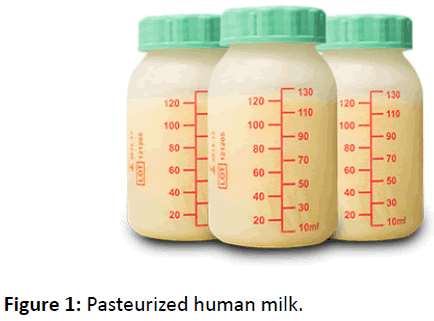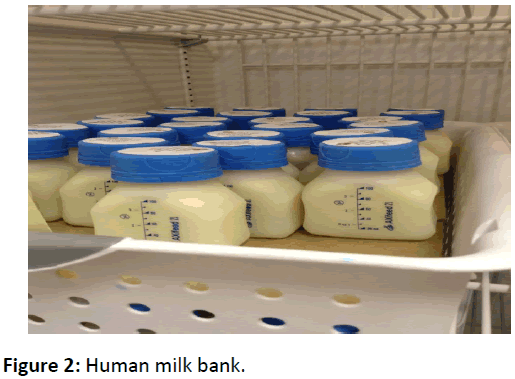Pasteurized Human Donor Milk as Nutraceutical
Ritika Gupta
DOI10.4172/2472-1786.100063
Ritika Gupta*
Department of Biotechnology, S.D. College of Engineering and Technology, UP, India
- *Corresponding Author:
- Ritika Gupta
Assistant Professor, Department of Biotechnology
S.D. College of Engineering and Technology, UP, India
Tel: 7060134245
E-mail: guptaritika.27@rediffmail.com
Received date: October 31, 2017; Accepted date: November 27, 2017; Published date: November 30, 2017
Citation: Gupta R (2017) Pasteurized Human Donor Milk as Nutraceutical. J Child Dev Disord. 3:25. doi: 10.4172/2472-1786.100063
Copyright: © 2017 Gupta R. This is an open-access article distributed under the terms of the Creative Commons Attribution License, which permits unrestricted use, distribution, and reproduction in any medium.
Abstract
Numerous preventive and therapeutic interventions have been designed to decrease mortality and disability in infants. In 2010, 7.6 million children who were less than 5 years of age died worldwide and 4.8 million were attributable to infectious causes. Among multiple preventive measures, early breastfeeding is one of the most important interventions to reduce neonatal and infant mortality. Due to human breast milk multiple antimicrobial, anti-inflammatory and immunoregulatory components which is also known as colostrum helps in protecting infants by serving as a source of nutrition uncontaminated by environmental pathogens in addition provides direct protection to the infants. Human milk can serve as a nutraceutical. Nutraceutical is the combination of the words “nutrition” and “pharmaceuticals” which is a food product that provides health benefits as an adjuvant or alternative therapy, thus including the treatment and prevention of infectious diseases in infants, children and adults. The objective is to create awareness about the nutraceutical properties of human breast milk and to review its benefits in the preterm population as well as to address colostrum’s future nutraceutical and therapeutic implications in newborns.
Keywords
Human milk; Newborns; HIV-infected patients; Nutrition
Introduction
Human colostrum can prevent or mitigate various diseases in newborns. It has been used as a nutraceutical for animals of all ages to increase resistance to infection and disease caused by a wide range of pathogens including bacteria, viruses, parasites and fungi. It is used for applications such as healing of intestinal lesions, improving host defence mechanisms, increasing the absorption of nutrients from the gastrointestinal tract, cognitive and visual development. It has been universally accepted that breast milk is an exclusive source of nutrition for the first six months of life, and also it is the part of the healthy infant diet for the first two years of life.
Some of the nutraceutical properties of intact milk proteins are they are the carriers of vitamins, minerals and fatty acids, anti-cancer properties, immunomodulatory properties, hypotensive properties, stimulation of intracellular glutathione, antibacterial properties etc. [1,2]. Health improvement in HIV-infected patients However, due to some reasons mothers of preterm infants are facing a number of barriers to providing sufficient milk volume to their babies.
There are various bioactive factors such as gastrointestinal hormones, lysozyme, immunoglobulins, lactoferrin, oligosaccharides, enzymes, antioxidants nucleotides, growth factors and cellular components that not only ensures adequate host defense against infections, but also actively modulate the immune response and also modify the intestinal bacterial flora. Growth factors like IGF-1, TGF (transforming growth factor), EGF (epidermal growth factor) are capable of stimulating gut growth and repair process of GI (gastrointestinal) tract. IGF-1 (insulin-like growth factor) induces protein synthesis, which leads to an increase in lean muscle mass without a corresponding rise in adipose (fat) tissue [3,4]. Platelet-derived growth factor (PDGF) which is a growth factor present in colostrum helps to stimulate the production of other growth factors, including IGF-1. Lactose is the major carbohydrate in human milk. Complex oligosaccharides are the second most abundant carbohydrate in human milk. Human milk oligosaccharides (HMOs) appear to have three important functions: prebiotic, decoy and provision of fucose and sialic acid that appear to be most important in host defense and neurodevelopment respectively. Components of human milk stimulate gastrointestinal growth and motility such as cortisol, insulinlike growth factors, somatomedin-C, insulin, and thyroid hormone affects the intestinal growth and mucosal function. Proline rich protein (PRP) from colostrum acts as regulatory substances of the thymus gland. PRP inhibits overproduction of lymphocytes and T cells and reduces pain, swelling and infection [5,6]. Human milk sIgA, growth factors, lysozyme, lactoferrin, bile salt-stimulating lipase, and HMOs all provide protective benefits that are responsible for the reduction in NEC. The immunoglobulins and lactoferrin present in colostrum are known to build natural immunity in newborns which helps to reduce the mortality rate in this population. Lactoferrin is the second most abundant protein in human milk; it has the highest concentration in the colostrum. It helps to prevent the growth of cancer cells or it shrinks the cancer cells. It is also known for its inhibitory action on cancer cells proliferation as well as for its antioxidant and antiinflammatory abilities against them. Conjugated linolenicacid (CLA) present in colostrum can be treated as a nutraceutical component and it also has anti-carcinogenic properties. CLA is said to inhibit carcinogens by inducing apoptosis through mechanism involving inhibition of eicosanoids synthesis. Lactoferrin prevents many cancers like bladder, colon, tongue, lung cancer and esophagus thus boosting the immunity [7]. It has antimicrobial, antinflammatory and anticancer properties together with its probiotic effect and the lack of any specific toxicity, allow it to be an ideal nutraceutical example. Also, the side-effect profile of colostrum proteins and possible lactose intolerance is relatively less in comparison with milk.
Feeding of human milk for all infants, term and preterm is supported by the American Academy of Pediatrics (AAP). Breast milk influences major short-term outcomes in very low birth weight including reduction in retinopathy of prematurity (ROP), bronchopulmonary dysplasia (BPD), and necrotizing enterocolitis (NEC). As a substitute for commercial formula, pasteurized human donor breast milk should be made available when the mother’s own milk is unavailable for the sick and hospitalized newborn. Donor human milk (DHM) may retain some of the non-nutritive benefits of maternal breast milk (Figure 1) however; feedings with preterm formula should ensure a more constant delivery of optimal levels of the nutrients. Although plant-based and bovine formulas approach the fat, protein and carbohydrate composition of human milk, they still are unable to replicate the complexity or functionality of other bioactive factors found in human breast milk. Therefore, donated milk which is being distributed through milk banks is becoming a desirable substitution to formula feeding. In an effort to reduce the risk of NEC, DHM is being used more frequently in neonatal intensive care units (NICUs) for very low birth weight (VLBW) infants and is endorsed by the AAP.
Over three decades, various non-profit milk banks have opened in cities across the United States and Canada. Human Milk Banking Association of North America is a non-profit organization which is working for the benefit of the society by providing donor human milk to babies in hospital NICUs (Figure 2). It also ensures the safety of pasteurized donor human breast milk [8]. The donor milk is pasteurized according to the guidelines which were established with the deliberation of the Centers for Disease Control, the blood and tissue industries and the Food and Drug Administration. Bacteriological testing is done by an independent lab before the pasteurized milk is dispensed to ensure its safety. Pasteurization is necessary to inactivate most of viral and bacterial agents and is well recognized that it maintains some of the mother’s milk beneficial and protective effects. There are some major challenges including the need for pasteurization, retain all of the nutritional and biochemical values of donor milk and a limited supply. Because of the manner in which donor milk is handled in human milk banks (HMB) many of the properties ascribed to mother's own milk are diminished or destroyed. Holder pasteurization method which is performed at 62.5°C for 30 minutes results in significant decrease in some of the bioactive factors but oligosaccharides and long-chain polyunsaturated fatty acids are not decreased. Currently as an alternative to thermal treatment, high-pressure processing (HPP) which is a novel non-thermal pasteurization technology is being increasingly applied in food industries worldwide.
Conclusion
Due to the nutritional composition of colostrum it is used as Ancient Food for Modern Times and hence can be considered as a nutraceutical. Human milk provides direct benefits to gastrointestinal function, nutrition, psychological well-being and host defence. The composition of the intestinal microbiota is mainly influenced by breast feeding in preterm infants. It works as immune modulator as well as have scope in maintenances of growth in children due to presence of growth factors. Some major steps should be taken to preserve the human milk and to establish human milk banks all over the world such as an evaluation of acceptability and requirement of analysis of costs; further research is needed to explore different cultural, religious and social attitudes towards donor milk; preparation of specific guidelines as a tool to optimize the functioning of existing Human Milk Banks; determine the minimal essential requirements to establish a new Human Milk Bank; trained health care workers in breast-feeding issues and counseling, and thus encouraging practices that do not undermine breast-feeding. Further research should be done to determine the optimal pasteurization method, to minimize the risk and to maximize bioactivity which could be beneficial to infants.
References
- Godhia M, Patel N (2013) Colostrum -Its Composition, Benefits As A Nutraceutical : A Review Current Research in Nutrition and Food Science Vol. 1: 37-47.
- Molloy T (2003) The roles of growth factors in tendon and ligament healing. Sports Medicine 33: 381-94.
- Playford RJ, Macdonald CE, Johnson WS (2000) Colostrum and milk-derived peptide growth factors for the treatment of gastrointestinal disorders. Am J Clin Nutr 72: 5-14.
- Giansanti F, Panella G, Leboffe L, Antonini G (2016) Lactoferrin from Milk: Nutraceutical and Pharmacological Properties. Pharmaceuticals.
- Rodriguez DA, Vazquez L, Ramos G (2005) Antimicrobial mechanisms and potential clinical application of lactoferrin. Rev Latino Microbiol 47: 102-111.
- Van der Strate BW, Beljaars L, Molema G, Harmsen MC, Meijer DK (2001) Antiviral activities of lactoferrin. Antivir Res 52: 225-239.
- Agarwal P, Gupta R (2016) A Review on Anticancer Property of Colostrum Research and Reviews Journal of Medical and Health Sciences.
- JH Kim, S Unger (2010) Human milk banking Paediatr Child Health 15: 595-598.
Open Access Journals
- Aquaculture & Veterinary Science
- Chemistry & Chemical Sciences
- Clinical Sciences
- Engineering
- General Science
- Genetics & Molecular Biology
- Health Care & Nursing
- Immunology & Microbiology
- Materials Science
- Mathematics & Physics
- Medical Sciences
- Neurology & Psychiatry
- Oncology & Cancer Science
- Pharmaceutical Sciences


